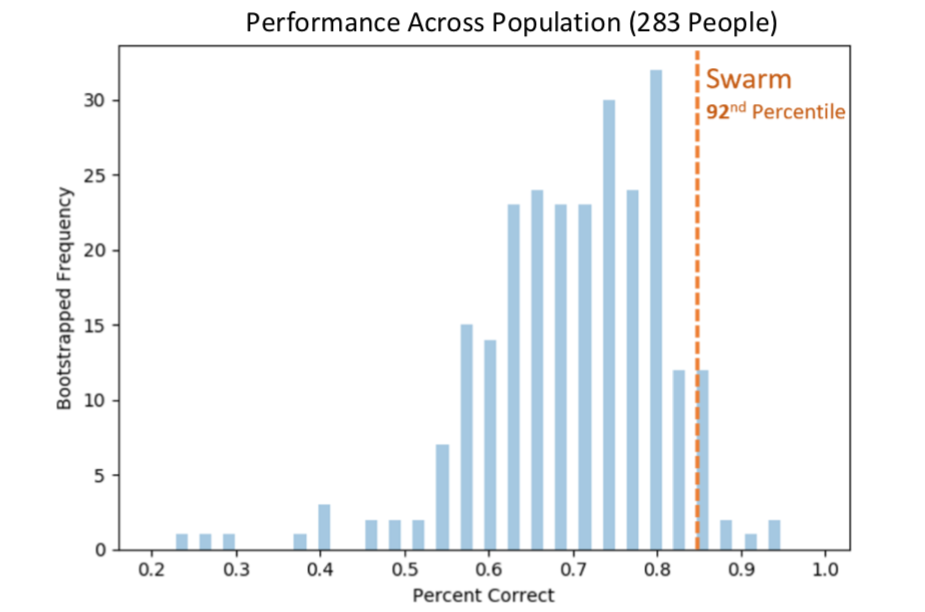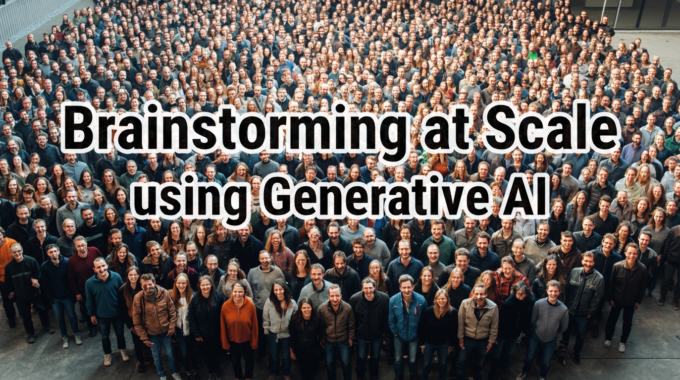
When using Swarm to amplify human insights, Market Researchers often ask – “How can Swarm bring together only 25 participants and generate results that are more accurate and insightful than a survey of hundreds or even thousands of respondents?”
.
The answer stems from the fact that Swarm is a very different instrument than a vote, poll, or survey. The quick video below conveys these differences using a very simple real-world example. The paragraphs below give a more detailed explanation.
.
As conveyed in the video, Swarm enables groups to converge on optimized insights by thinking together, moderated by AI algorithms. The primary benefits of Swarm over traditional methods can be summarized as follows:
.
Active vs Passive: The most important thing to know about Swarm is that it treats participants as active members of an interactive control system, with feedback loops that enable the group to explore a set of options and converge on solutions that maximize their collective conviction. This is very different than polling, which treats each person as a passive source of data-points for statistical aggregation. Thus, while polling finds the average answer across a group, swarming enables groups to interactively weigh the issues at hand and find the solutions they can best agree upon. This is one reason why surveys often require hundreds, if not thousands of respondents, while swarms of just 25 to 50 people have been shown to converge on repeatable, reliable results [1,2,3].
.
Behaving vs Reporting: When conducting surveys, researchers generally ask participants to self-report their sentiments. Unfortunately, studies show that individuals are highly unreliable when reporting their feelings [4, 5]. Even if they are in-touch with their true sentiments, quantifying sentiments in a form that can be aggregated across groups is very difficult, as every individual has different internal scales [6, 7, 8]. This means the underlying data used by traditional surveys is often highly distorted. Swarming, on the other hand, does not rely on participants to report their sentiments, but instead uses intelligence algorithms to processes how they behave while interacting as part of the real-time system. This behavioral data enables the Swarm platform to accurately estimate, at each time-step, the relative conviction expressed by each individual with respect to the answer options.
.
Average Responses vs Optimal Solutions: Whether you’re a market researcher or a political pollster, surveying a population is the most common method for capturing opinions. You might find that 35% of a population prefers Option A, while 25% prefers B, 20% prefers C, and 15% prefers D. You might conclude from this that Option A is the “best” choice, but that does not mean it will optimize the satisfaction of the population. Or you could use Swarm, which is not aimed at profiling the differences within a population but instead uses Swarm AI algorithms to find the solution that the population can best agree upon. In a recent study, Swarm was compared to Plurality votes, Borda Count (i.e. ranked polling) and the Condorcet method (pairwise polling). As published, the swarming process converged on optimal solutions 82% of the time, as compared to the traditional methods, which only found optimal solutions 60% of the time.
.
Academic Validation: A wide variety of academic studies have shown Swarm to significantly amplify the accuracy of insights generated from human groups. For example, a recent study conducted at California Polytechnic administered a standard subjective judgement test to over 283 people using an online survey. Each test included 35 questions, thereby generating approximately 10,000 survey responses. The survey results were then compared to 66 small groups of 3 to 5 people answering the same questions using Swarm. As shown below (and detailed in the full paper) the small groups using Swarm, on average, outperformed 92 percent (p<0.001) of survey respondents.
.

.
In addition, the full paper takes the analysis one step further, showing that if we select five small groups at random and have each group answer using Swarm, and then aggregate the results, the performance lands in the 96th percentile (top 4 percent) of the survey responses. Furthermore, this group (of approximately 18 people) achieved a more accurate score (by 1.6%) than if all 283 surveys were aggregated statistically. In other words, using 1/16 the number of participants, the Swarm platform generated more accurate results (P<0.001).
.
Final Guidance: Swarming is a unique and powerful method for harnessing the knowledge, wisdom, and insights of human groups. While it’s tempting to compare the process to polls, surveys, and focus groups, the relationship is tenuous. Swarming is a unique instrument that treats participants as active members of a real-time system that converges on optimal solutions, while polling treats individuals as passive datapoints in a statistical distribution. At the same time, swarming is an interactive process that evokes authentic sentiments by processing behaviors as participants act, react, and interact with others. For more information on how Swarm AI works, the Swarm Whitepaper is a good resource. Our Case Studies page is also useful for examples of how businesses are using Swarm to solve real-world problems.
Want to learn more about our Swarm AI technology? Check out our TED talk below…




